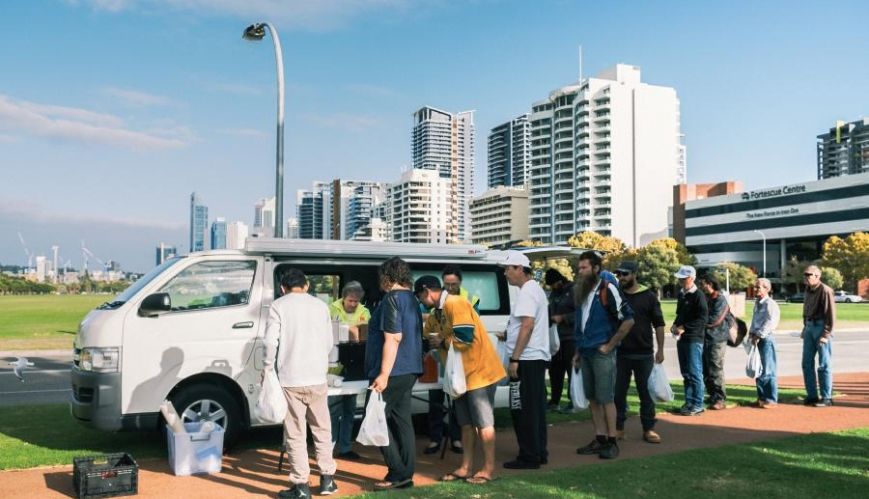Collaboration to end homelessness

Collaboration to end homelessness
28 July 2020
Perth Doorways homelessness breakfast program. Photo Joel Gibson
The Homelessness Stream of The Salvation Army Australia Territory has an audacious goal – to eradicate rough sleeping and street sleeping across the nation.
“It can be eliminated!” exclaims Livia Carusi, the Army’s General Manager for Homelessness. “We have examples of this internationally, but there are a number of things that have to go in to make it happen here in Australia. There has to be a strong political will, a collective desire to end street sleeping, a drive to building the necessary societal structures, and stimulating the economy in a way that allows for affordable housing.”
Transitioning The Salvation Army to a national structure over the past few years has been the right move, according to Livia. “We now have one organisation, working towards one mission, and one vision and in the spirit of a distinct set of values.” she says.
“In response to the change in the national structure, we have been able to build a new shared mission across our stream. Our framework shows the shared set of values and shared vision we are aspiring to achieve. This framework will continue to evolve and grow with the circumstances we face. “Also, there are a myriad of examples of collaboration between our team and other mission expressions and we have great working relationships with many departments who help us achieve our goal!”
Over the past year, the Homelessness Stream has been involved with many other mission expressions across the Army – Human Resources, Salvos Housing, the Finance Department and Contracts – as they drafted and designed their national agenda. There is a real intentionality to integrate as much as possible.
“In a tangible and meaningful way we want to bring departments and other mission expressions across the boardto the table and to have people really engaged with the process,” says Livia. “We have also created working groups in all the states that have representation from different parts of the organisation. The chair of most of these groups is the divisional commander. It’s excellent to have them involved and it helps to make sure what we create doesn’t just become another document sitting on a shelf, that we really work towards action.”
The Homelessness Stream has developed or is in the process of developing, agendas which relate to each states’ specific needs for the next three years. They are based on the national agenda, but identify things that are unique to that state and address how they will be tackled. It is customised cohesion. For example, in Victoria there is a focus on involvement with people who are exiting the justice system, as they have been identified as a group in the community that is being left behind and need extra support.
The collaboration doesn’t stop at the designing of the national framework; there are many stories of the Home- lessness Stream collaborating with other parts of the Army as well as external partners. In Tasmania, the Homelessness Team has partnered with Hobart City Mission to create a Safe Night Space.
“This initiative is to directly combat the large number of people sleeping in parks, gardens, in the domain, on the beach, or on the street,” says Dr Jed Donoghue, State (Tasmania) Manager for Housing and Homelessness. “We have had over 158 clients in the first three months of operation!”
For an initiative like this to work, Jed and his team have been partnering with external organisations, but they also have a crucial partnership with Hobart Corps. The corps has been providing meals, engagement with clients and material assistance. Due to the success of the model and the increasing pressures people have been put under with the COVID-19 crisis, the Safe Night Space has been opened 24 hours a day, seven days a week. It has been rebranded as Safe Space and is being expanded into Launceston and Burnie.
This story highlights the need to be focused more on the preventative side of homelessness. “We need to divert people away from needing support in the homelessness system and focus more on early intervention and resolving housing issues that people are faced with before they become homeless,” says Livia. “This is what will break the cycle of homelessness. We need to think about the provision of long-term support to housing, including social housing, and have less of a push towards crisis and emergency accommodation as the solution.”
Comments
I have read with strong interest on the proposition of eradicating homelessness. I work with people coming out of incarceration and this is a difficult space without designated housing to start their transition back to the community. I for one have been trying to make this happen but lack of financial backing makes this difficult. Without housing it is a backward step on integration in a positive way. Having to deal with mental health, drugs and alcohol issues and financial challenges initially makes it all the more testing. I would love to see more opportunities to work (with financial support) in collaboration with other organisations to harness the broader option. We do have organisations locally that want to remedy this harsh reality.